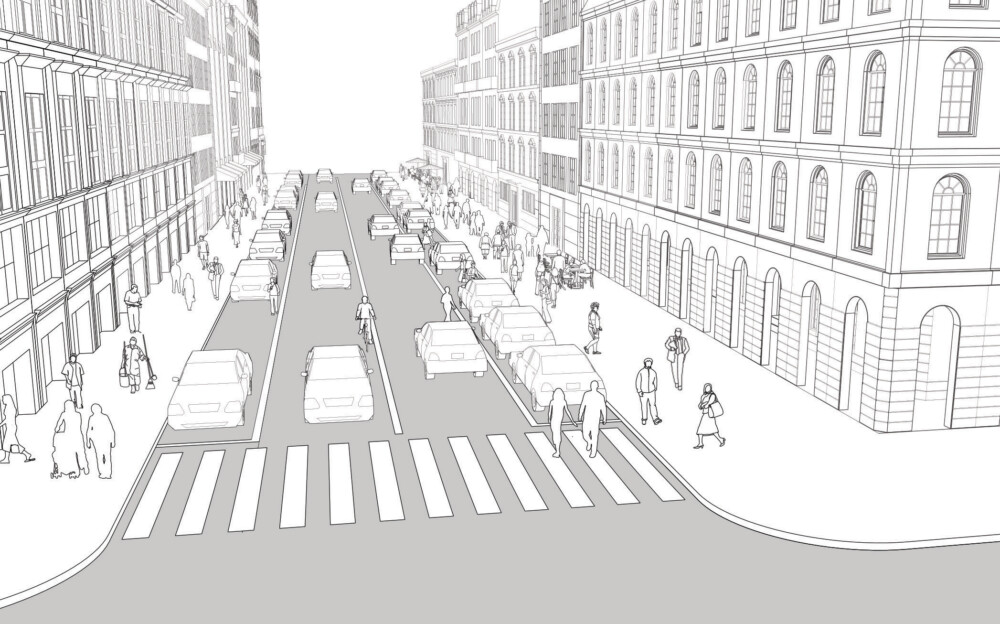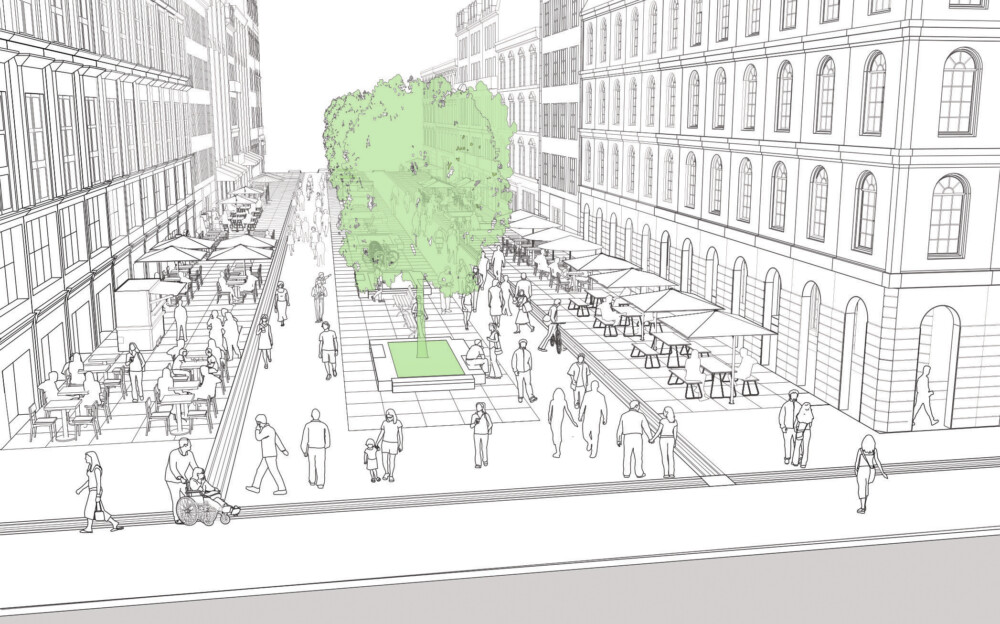-
About Streets
- Introduction
- Defining Streets
-
Shaping Streets
- The Process of Shaping Streets
- Aligning with City and Regional Agendas
- Involving the Right Stakeholders
- Setting a Project Vision
- Communication and Engagement
- Costs and Budgets
- Phasing and Interim Strategies
- Coordination and Project Management
- Implementation and Materials
- Management
- Maintenance
- Institutionalizing Change
- Measuring and Evaluating Streets
-
Street Design Guidance
- Designing Streets for Great Cities
- Designing Streets for Place
-
Designing Streets for People
- Utilities and Infrastructure
- Operational and Management Strategies
- Design Controls
-
Street Transformations
- Streets
-
Intersections
- Intersection Design Strategies
- Intersection Analysis
- Intersection Redesign
- Mini Roundabout
- Small Raised Intersection
- Neighborhood Gateway Intersection
- Intersection of Two-Way and One-Way Streets
- Major Intersection: Reclaiming the Corners
- Major Intersection: Squaring the Circle
- Major Intersection: Cycle Protection
- Complex Intersection: Adding Public Plazas
- Complex Intersection: Improving Traffic Circles
- Complex Intersection: Increasing Permeability
- Resources
Global Street Design Guide
-
About Streets
- Introduction
- Defining Streets
-
Shaping Streets
Back Shaping Streets
- The Process of Shaping Streets
- Aligning with City and Regional Agendas
- Involving the Right Stakeholders
- Setting a Project Vision
- Communication and Engagement
- Costs and Budgets
- Phasing and Interim Strategies
- Coordination and Project Management
- Implementation and Materials
- Management
- Maintenance
- Institutionalizing Change
-
Measuring and Evaluating Streets
Back Measuring and Evaluating Streets
-
Street Design Guidance
-
Designing Streets for Great Cities
Back Designing Streets for Great Cities
-
Designing Streets for Place
Back Designing Streets for Place
-
Designing Streets for People
Back Designing Streets for People
- Comparing Street Users
- A Variety of Street Users
-
Designing for Pedestrians
Back Designing for Pedestrians
- Designing for Cyclists
-
Designing for Transit Riders
Back Designing for Transit Riders
- Overview
- Transit Networks
- Transit Toolbox
-
Transit Facilities
Back Transit Facilities
-
Transit Stops
Back Transit Stops
-
Additional Guidance
Back Additional Guidance
-
Designing for Motorists
Back Designing for Motorists
-
Designing for Freight and Service Operators
Back Designing for Freight and Service Operators
-
Designing for People Doing Business
Back Designing for People Doing Business
-
Utilities and Infrastructure
Back Utilities and Infrastructure
- Utilities
-
Green Infrastructure and Stormwater Management
Back Green Infrastructure and Stormwater Management
-
Lighting and Technology
Back Lighting and Technology
-
Operational and Management Strategies
Back Operational and Management Strategies
- Design Controls
-
Street Transformations
-
Streets
Back Streets
- Street Design Strategies
- Street Typologies
-
Pedestrian-Priority Spaces
Back Pedestrian-Priority Spaces
-
Pedestrian-Only Streets
Back Pedestrian-Only Streets
-
Laneways and Alleys
Back Laneways and Alleys
- Parklets
-
Pedestrian Plazas
Back Pedestrian Plazas
-
Pedestrian-Only Streets
-
Shared Streets
Back Shared Streets
-
Commercial Shared Streets
Back Commercial Shared Streets
-
Residential Shared Streets
Back Residential Shared Streets
-
Commercial Shared Streets
-
Neighborhood Streets
Back Neighborhood Streets
-
Residential Streets
Back Residential Streets
-
Neighborhood Main Streets
Back Neighborhood Main Streets
-
Residential Streets
-
Avenues and Boulevards
Back Avenues and Boulevards
-
Central One-Way Streets
Back Central One-Way Streets
-
Central Two-Way Streets
Back Central Two-Way Streets
- Transit Streets
-
Large Streets with Transit
Back Large Streets with Transit
- Grand Streets
-
Central One-Way Streets
-
Special Conditions
Back Special Conditions
-
Elevated Structure Improvement
Back Elevated Structure Improvement
-
Elevated Structure Removal
Back Elevated Structure Removal
-
Streets to Streams
Back Streets to Streams
-
Temporary Street Closures
Back Temporary Street Closures
-
Post-Industrial Revitalization
Back Post-Industrial Revitalization
-
Waterfront and Parkside Streets
Back Waterfront and Parkside Streets
-
Historic Streets
Back Historic Streets
-
Elevated Structure Improvement
-
Streets in Informal Areas
Back Streets in Informal Areas
-
Intersections
Back Intersections
- Intersection Design Strategies
- Intersection Analysis
- Intersection Redesign
- Mini Roundabout
- Small Raised Intersection
- Neighborhood Gateway Intersection
- Intersection of Two-Way and One-Way Streets
- Major Intersection: Reclaiming the Corners
- Major Intersection: Squaring the Circle
- Major Intersection: Cycle Protection
- Complex Intersection: Adding Public Plazas
- Complex Intersection: Improving Traffic Circles
- Complex Intersection: Increasing Permeability
- Resources
- Guides & Publications
- Global Street Design Guide
- Streets
- Pedestrian-Priority Spaces
- Pedestrian-Only Streets
- Example 2: 10 m
Example 2: 10 m


Additional Considerations
In some cases, a complete pedestrianization may be appropriate only for a few blocks where pedestrian traffic is the highest.
The types of businesses and land uses that occupy the pedestrian corridor and its side streets will affect the street’s function and character at different times of day.
Temporary pedestrianization, using bollards, posts, and diverters, can provide an opportunity to collect comparative data and determine the impacts of closing the street to traffic permanently.1
Shared streets or other pedestrianpriority streets can be implemented in streets with lower pedestrian volumes to complement pedestrian-only streets or transit. See: Shared Streets.
Provide signs that encourage cyclists to disembark and walk with their cycles, especially in high pedestrian-volume corridors.
Depending on pedestrian density and street width, it may be appropriate to allow cycles in the street if they travel close to walking speeds.

Istanbul, Turkey. Istiklal Avenue is one of the most famous avenues in the city, stretching 1.4 km and lined with a mix of cultural and commercial uses in historic buildings. Measuring approximately 15 m wide, this avenue was pedestrianized in the late 1980s and still runs an occasional historic tram down the center.
LIUYUN XIAOQU; GUANGZHOU, CHINA
Located in the city’s central commercial area, Liuyun Xiaoqu is a dense, mixed-use neighborhood with mid-rise buildings set into small blocks, constraining the amount of street space available. Because the street space is so limited, most of it is dedicated to pedestrians, and motor vehicles are prohibited from entering. Parking provision is very limited and controlled at the perimeter.
Initially, Liuyun Xiaoqu was a gated, single-use residential block, typical of the housing estates built in the late 1980s. Since 2000, when the tenants in the buildings gained the titles to their apartments, the owners started converting their premises to commercial uses, at first for local shops and later for designer clothes and cafés. The ground floor conversions began in 2003, starting near Tianhe Plaza, and eventually expanded until nearly all the ground floors was converted to commercial use, turning the area into an open, mixed-use neighborhood. Leading up to the 2010 Asia Games, which were held in close proximity to the neighborhood, the municipality improved the utilities and infrastructure, invested in the pedestrian areas and landscaping, and added some architectural ornamentation.
The district is well-served by nearby BRT and Metro rail stations, which makes it an accessible destination regionally and connects residents and visitors to the larger transit network.

Liuyun Xiaoqu; Guangzhou, China
Footnotes
1. Times Square, Broadway model, NYC, USA. Closed for one year, before and after metric were collected, showing a range of benefits of the closure.
Adapted by Global Street Design Guide published by Island Press.
Next Section —